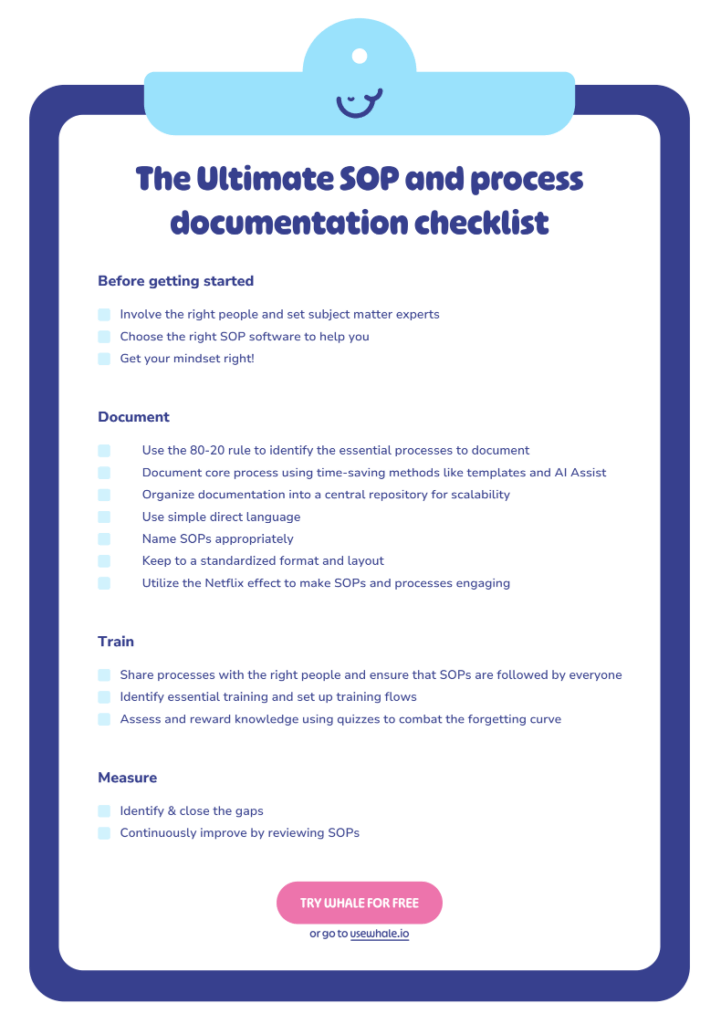Ever wondered what keeps an agency ticking like a Swiss watch, even when chaos knocks on the door? Cue the unsung hero of the organizational world: standard operating procedures, or SOPs for short.
So what ingredients go into a standard operating procedure for an agency that’s not just good on paper but great in action?
We’ll cover the details below step-by-step.
Why Are Standard Operating Procedures (SOPs) Important for Agencies?
Standard Operating Procedures are essential for agencies as they ensure a consistent and efficient service delivery. These procedures act as a guide, delineating roles and responsibilities within the team. They streamline operations, ensuring adherence to best practices at all times.
By standardizing processes, SOPs;
- guarantee uniformity across different projects and teams,
- reduce the possibility of errors or miscommunication.
- And equip agencies for growth, enabling quick integration of new employees, efficient task delegation, and sustained quality control as the agency expands.

For new team members, the SOP is indispensable, simplifying complex internal procedures into manageable steps, which streamlines the onboarding process and ensures consistency in task execution.
In a nutshell, your SOPs allow you to step out of the business without everything falling apart. Instead, your team members can take ownership of specific tasks with consistency across departments.
Process documentation shouldn’t be perceived as a constraint on creativity; rather, it provides a foundational framework that allows your team to concentrate on their core competencies, with the SOPs handling the operational aspects.
For agencies aiming to scale their operations, developing comprehensive SOPs is a strategic move towards achieving long-term success.
7 Steps to unclock growth with Agency SOPs
Okay so you know that SOPs are the secret to winning more client pitches and campaigns.
But how do you start? And where?
Here are the 7 steps you need.
1. Analyze past processes
To initiate the process of enhancing efficiency within your agency, start by evaluating your existing procedures comprehensively. Analyze how tasks are currently performed and pinpoint any pain points or areas that could benefit from improvement. Pay particular attention to tasks that are repetitive and consume substantial time and effort, as these tasks are prime candidates for the development of Standard Operating Procedures (SOPs).
Furthermore, identify areas prone to errors or inconsistencies, such as tasks requiring collaboration among team members or involving complex steps. By identifying these critical areas, you can create SOPs that provide clear instructions and minimize the risk of mistakes.
Additionally, consider processes that suffer from a lack of standardization, resulting in wasted time. Inconsistent approaches can lead to confusion and inefficiencies. Through SOP implementation, standardize these processes to ensure a uniform methodology, saving time and promoting a seamless workflow.
2. Consider naming conventions
The name of an SOP document is a cornerstone for identification that serves as an immediate indicator of the business process described.
Say your agency manages content marketing for clients. A process for creating new articles could have a simple header of “Article Generation Process.”
An agency can have dozens of internal processes that may require an SOP. Think of the header name like the book title in your SOP library. It should clearly define what’s inside the SOP so you can navigate to it quickly.
3. Know the purpose of the Agency SOP
The purpose section outlines the SOP objectives, the departments it encompasses, and the results it aims to achieve. It gives users a snapshot of what they’ll find inside and the outputs that are expected when using the SOP.
Take client onboarding as an example process. The purpose section would describe onboarding as the goal and outline things like how fast you expect onboarding to take and how many clients you should be able to onboard in a specific timeframe.
4. Consider roles and Responsibilities
While the purpose section briefly reviews stakeholders and departments, this section goes into detail on who’s doing the work.
Say you have a web design agency and your team uses email sequence software to fill your funnel. An SOP on your email campaign process would break out all the relevant responsibilities. It would outline who prospects for email addresses, who creates the email content, who manages the sending schedule, who analyzes the results, and so on.
Each role must be articulated, including the responsibilities, the scope of their authority, and the expected outcomes. Every team member should be aware of their contribution to the agency’s overall objectives in the SOP.
For procedures with extensive responsibilities, you might want to create separate documents, each focusing on a distinct sub-process and their associated roles.
6. Document your processes (Only 20%)
Now, we’ve come to the meat and potatoes of the matter but first, consider this.
80% of the results of what you do come from 20% of your processes. So don’t go waste time trying to document everything.
Also don’t waste time documenting from scratch!
Just remember these key points;
- Your SOP should be easy to understand, above all, or no one will read them or use them.
- Get started with templates or AI-assist from Whale which will give examples that can easily be adapted for your agency.
You might be tempted to make a comprehensive standard operating procedure for a large workflow that should have many individual SOPs within it. Think of your SOP library like Wikipedia and individual SOPs like pages about a certain topic. With a good hierarchy and dashboard, your team can navigate specific SOPs to get the information they need.
7. Adopt Agency SOP Version Control
SOPs are living and evolving within an organization. You might have a completely different process for prospecting six months from now than you do today. For example, you might discover LinkedIn lead generation becomes an important source of leads for your agency in the future, and you’d add that to your prospecting SOP.
So it’s important to have a definitive protocol for the modification of SOPs. Identify individuals with the authority to make changes and outline a structured review and approval procedure to ensure quality standards are upheld.
Document every amendment in a version history record, noting the individual responsible for the change and the reason behind it. This record will provide a valuable reference for training, audits, and refining processes.
The good news is you don’t have to manage your library of SOPs and each of their versions manually. SOP management software can help organize all your documents into a dashboard so your team can access what they need easily. You can also use software like Whale to create engaging SOP content and add elements like GIFs and videos.
The Ultimate SOP Checklist for your agency
It doesn’t stop at documenting your agency processes.
You’re going to need to have them organized and share them with your team.
The best software will allow you to;
- Onboard and train your team members on your processes and will include features like automated roll-out.
- Review and update your processes with automated review reminders.
- Provide ROI.

Bottom line? Use SOPs at Your Agency to Boost Productivity
You’ve seen how step-by-step instructions in SOPs can minimize chaos. SOPs are your agency’s key to consistency.
When you write standard operating procedures, you’re not just jotting down necessary steps, you’re crafting a blueprint for success. Sure, the process may seem daunting, but with the right SOP software, it’s easy.
Creating SOPs is like building a toolkit that everyone within the organization can use.
Need to scale your agency? SOPs are your ladder. And remember, an effective SOP isn’t a one-and-done deal. It’s a living document – review and update the SOP to keep it fresh.
By now, you know that the purpose of an SOP goes beyond just a step-by-step process – it’s the backbone of effective communication. So, don’t just sit on this goldmine. Write standard operating procedures, sprinkle in some clear SOP formatting, examples, and resources, and watch your agency thrive.



